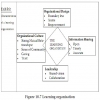Strategic Management - Strategy Implementation
Defined and Levels of Managing Change
Posted On :
According to Stephen P. Robbins change is concerned with making things different.
Change – Defined
According to Stephen P. Robbins change is concerned with making things different. Change occurs when an organizational system is disturbed by some internal or external force, occurs.Change, as a process, is simply modification of the structure or process of a system. It may be good or bad, the concept is descriptive only.”
In the context of change we come across certain terms like change agent, change intervention and change targets.
1. Change agent is the person or persons who acts as a catalyst, and assumes the responsibility for managing the change process.
2. Change intervention, is a planned section to make things different.
3. Change targets are individuals and groups who are subject to change.
Levels of Change
Change occurs at three levels
1. Individual level
2. Group level and
3. Organization level
At the individual level change is reflected in such developments as changes in a job assignment, physical move to a different location, or the change in maturity of a person which occurs overtime. It is said that changes at the individual level will seldom have significant implications
Most organizational changes have their major effects at the group level. This is because most activities in organizations are organized on a group basis. The groups could be departments, or informal work groups. Changes at the group level can affect work flows, job design, social organization, influence and status systems, and communications patterns.
Changes at the organization level involve major programmes that affect both individuals and groups. Decisions regarding these changes are generally made by senior management and are seldom implemented by only a single manager. Frequently, they occur over long periods of time and require considerable planning for implementation. Example of these changes would be reorganization of the organizational structure and responsibilities, revamping of employee remuneration system, or major shifts in an organization’s objectives.
Tags : Strategic Management - Strategy Implementation
Last 30 days 506 views
















